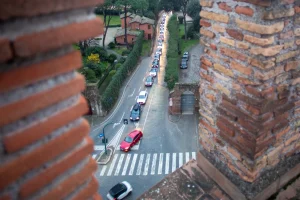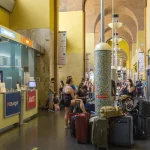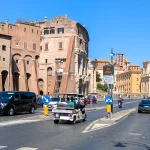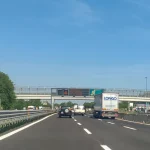Italy is a wonderful country to explore by car. From the Alps to the Adriatic coast and through picturesque old towns, driving in Italy offers a unique sense of freedom.
Driving in Italy – the most important facts at a glance
Knowing the most important traffic rules, tolls and peculiarities of Italian road traffic will ensure you are well prepared.

You will need:
- International Driving Permit (IDP): A driving licence (an EU driving licence is valid, but a non-EU citizen may require an international driving licence)
- Car Documents: Always have your vehicle’s registration and proof of insurance with you. If you’re renting a car, the rental company will provide these.
- A safety vest, a warning triangle and a spare tyre
Traffic rules in Italy – what you must observe
Speed Limits in Italy
Speed limits are clearly posted but strictly enforced, often with cameras.
- Highways (Autostrade): 130 km/h → 81 mph (reduced to 110 km/h / 68 mph in rain)
- On expressways: 110 km/h → 68 mph
- Main roads outside cities: 90 km/h → 56 mph
- Urban areas: 50 km/h → 31 mph
- Residential or school zones: often 30 km/h → 19 mph
Alcohol Limits
Penalties include high fines, license suspension, and in severe cases, even vehicle confiscation.
- Standard legal limit: 0.5‰ (about 0.05%)
- For new drivers (under 3 years of license) or drivers under 21: zero tolerance
Obligatory seat belts, mobile phone ban, compulsory helmets and daytime running lights
- Seat belts are compulsory for all passengers.
- Phone calls can only be made using a hands-free system.
- Helmets are compulsory for motorcyclists and moped riders.
- Daytime running lights are mandatory.
Tolls in Italy – how the system works
Freeway tolls and payment system
Most motorways are subject to tolls. You take a ticket when you enter and pay in cash or by card when you exit. On some motorways in northern Italy, you can pay the toll online after your journey.
Telepass in Italy – is it worth it?
With Telepass, you can pay tolls electronically and drive through special lanes without stopping, which is practical for frequent drivers.
Special rules for motorcycles & multi-axle vehicles
- Motorcycles often pay less toll.
- Motorhomes and caravans are classified more expensively.
Fines & penalties – what you need to watch out for
Common traffic violations and their costs
- Wrong parking: from approx. 40 €
- Speeding: from approx. 45 € (in urban areas), significantly more expensive on highways
- Cell phone driving: from approx. 160 €
ZTL zones in Italian cities
“Zona a Traffico Limitato (ZTL)” are traffic-calmed city centers, often monitored by cameras. Anyone entering without a permit will automatically receive a fine.
Parking in Italy – tips & traps
- White lines: free of charge
- Blue lines: subject to charge
- Yellow lines: reserved (e.g. for authorities)
Driving a rental car in Italy
What to look out for when booking a rental car?
It pays to book early. Make sure you have sufficient insurance cover and fair fuel regulations.
Insurance & deposit
Additional insurance, such as fully comprehensive insurance with no excess, is recommended. Deposits are often blocked on credit cards.
Traffic rules, especially for tourists
Many violations (e.g. ZTL) will be passed on to you via the car rental provider, including an additional processing fee.
Driving an electric car in Italy
Charging stations in Italy – providers & density
The network is growing rapidly. The major providers are Enel X Way and Be Charge. Their Enel On Your Way and Plenitude On the Road apps are available in several languages. With apps, you can activate pay-per-use rates, among other things. There are also smaller providers and a Tesla charging network. With many domestic and foreign charging cards, you can access most charging stations in Italy. Coverage is good, especially in cities and along highways.
Charging systems & plug standards
- AC charging: Type 2
- DC fast charging: CCS2, CHAdeMO
- Power: from 11 kW to over 350 kW (ultra-fast charger)
Charging and payment apps and cards
The most important Italian apps are Enel X and Plenitude. However, international apps such as Plugsurfing also work well. Charging is usually controlled via the app’s road map function or alternatively via RFID using the app or a special card. Some charging stations also accept credit card payments.
Special rules for e-cars in Italy
- In some cities, electric cars are permitted to enter ZTL zones or park free of charge in blue parking spaces.
- Mostly free parking is available during the charging process.
- Regional toll discounts are also available
Refueling & petrol prices in Italy
Different systems at petrol stations
- Servito: Attendant service, more expensive
- Self-service: cheaper, automatic filling station.
Gasoline and diesel prices in Italy
Prices are similar to those in Germany and France, but they differ significantly between highways and cities.
Tips for filling up cheaply
- Off-highway gas stations are significantly cheaper
- It is worthwhile to compare prices via an app
Practical tips for safe driving in Italy
What to do in the event of an accident
If an accident occurs, stay calm. Secure the accident site with a high-visibility vest and warning triangle. In the event of a major accident, call 112 to coordinate the police and rescue services. For minor damage, it is advisable to complete a European accident report form. Photos and witness details are also helpful.
If your vehicle needs to be towed, call your insurance company’s emergency number. If you do not have breakdown cover, you can call the Italian Automobile Club on 800 116 800 (English-speaking service) or 803 116 to arrange to have your car towed away for a fee.
Protection against theft and car break-ins
Do not leave luggage or valuables on view in your car, and if possible, park in a guarded car park. Vehicles should not arouse the interest of thieves, especially in quiet side streets and at night.
Beware of fraud attempts!
Occasionally, fake accidents occur, such as the so-called ‘mirror trick’. In this case, fraudsters claim that you have damaged their car. Motorcyclists or cyclists may show you an abrasion on their leg. Stay calm in such situations, call the police, and never pay the alleged victim directly.
Driving in Rome, Florence and Naples
Narrow streets, heavy traffic and lots of scooter drivers mean that composure and defensive driving are crucial.
You can find more information about driving in Rome here.
Driving in Sicily & Tuscany
Roads are often narrow in rural regions, but they offer wonderful panoramas.
Winter tires compulsory
They are compulsory in some regions of northern Italy and on other routes in mountainous areas. As a rule, this begins on 15 November, but in some regions or in certain weather conditions it may begin earlier. In certain circumstances, it may only be possible to continue driving with snow chains. Winter tyres may no longer be used from 15 April.
Cultural differences in road traffic
Italians often drive more spiritedly. In central and southern Italy, you can observe a kind of swarm intelligence in city traffic. Therefore, it is important to maintain all-round visibility, adapt to the flow of traffic, avoid insisting on your supposed rights, stay calm and drive with foresight.
Conclusion – mastering driving in Italy in a relaxed mannern
If you familiarise yourself with the traffic rules, factor in tolls and exercise caution in ZTL zones, you can easily explore Italy by car. The country now offers a dense network of charging stations for electric car drivers, and even special rights in cities. This makes driving in Italy a pleasant and safe travel experience.

Car Rental in Italy – Everything You Need to Know
A rental car is the ideal way to discover Italy in a flexible and independent manner. Whether it’s picturesque coastal…>>>

ZTL Italy · Driving Bans in Rome, Florence, Bologna & Milan
If you travel through Italy by car, you will quickly encounter the so-called ZTL zones (Zona a Traffico Limitato). These…>>>

Tolls, Telepass, and Safety: Understanding Italian Highways in 2025
For many travelers, tolls in Italy are an important topic because almost all highways require a fee. Knowing how the…>>>
Disclaimer
All information is without guarantee. Special regulations apply for some groups of people (e.g. novice drivers) or vehicle types. For specific information, please contact your automobile club or embassy.
